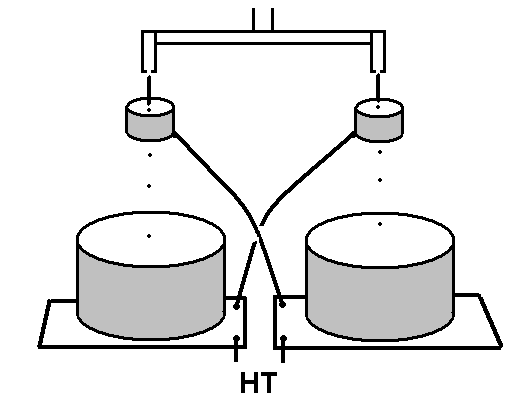



Above the rings are two water spouts that produce water drops from a water reservoir. The water tank can be earthed or left floating (electrically). A compression clamp is used to adjust the water flow so that we have as greatest number of drops produced as possible without the water coming out as a continuos flow. Normal tap water seems to work fine.

Now at the start we assume that one pot will tend to be slightly more positively charged than the other. So let us say, for the sake of argument, that the left hand (LH) pot is positive and the right hand (RH) pot relatively negative. As the LH pot is wired to the RH ring the RH ring will become positive while the LH ring negative (because they are directly wired pot-to-ring).
If a drop of water falls through the RH ring the positive charge on the ring will induce a negative charge on the drop. As it passes through, this now negative drop will fall into the RH pot, which already negative will now acquire even more negative charge from this charged drop of water.
In the mean time a drop falling through the LH ring will have a positive charge induced (by the negative ring) and thus fall into the positive pot thereby increasing the positive charge on this pot still further.
As each pot has acquired more corresponding charge each of the crossed wired rings will be more charged and thus will induce more charge on the subsequent drops falling through them. In quite a short time then the two pots will quickly build up positive and negative charge in the same way money in a bank account increases in value due to more money being added in and compound interest being added on to the whole lot!
Note on construction
My first version was lovingly made out of plywood and varnished several times to make water tight and look nice but it completely failed to work. I still used Perspex insulators where I thought they were needed. I was surprised that it did not work at all.
After much experimentation and reading through various books and the web I decided to ditch the wooden support structure and make a Perspex only construction. This worked correctly the first time it was assembled. It appears that wood is too poor an insulator to be even close to the crucial parts of the apparatus and has the effect of stoping the build up of any charge, stalling the generator.
The two cross wires must be made of well insulating wire (you can use inner of TV coax or rubber coated wires) and even though insulated should not physically touch each other anywhere. Any loss of integrity of the insulators will stop any charge building up and consequently stop anything happening at all.
All insulators need to be clean and dry.
Emptying water full pots
The two pots sit on metal plates from which the cross wires and the output connections are made. The pots make connection sitting on the plates. When the pots are full with water they can simply be picked up and poured back into the tank (but you will need to start again as you will discharge the apparatus in the process).
Kick Start
The obvious problem with this generator is that it needs the two pots to have slightly different charges upon them in order for the generator to work. In order for this to be so the insulators supporting the pots need to be as good as possible, otherwise any charge difference will simply leak away too quickly.
If the insulators are slightly lossy you can kick-start the charge build-up process by bringing a charged body (such as a comb, or plastic ruler suitably charged by wiping in a cloth or clean hair) near to one of the pots. This will accelerate the process and might overcome the initial losses that stop the generator working.
I have an 2kV electrostatic voltmeter that goes full scale defection in a few seconds using this marvellous machine! If you connect one wire of a neon bulb to one pot and the other wire almost touching the other pot the neon will flash when the potential reaches high enough to jump the air gap between neon wire and pot.
How it works II
The above discription basically accounts for how the machine works but how exactly does the machine seperate charge and what role do the drops play? As the water flows through the rings the voltage on the ring attracts (by columb attraction) the (oppositly charged) ions in the water stream. So if the ring was negative the stream of water flowing through would have positive ions drawn to the surface. When this stream of water brakes off into little water drops, each drop takes away some of this charge. Each drop adds this charge to a pot. The difference in charge between the two pots is the voltage we measure (the voltage is the energy of attraction between the oppositly charged pots).
References
[1] Kelvin, Wikipedia pages
[2] Electrostatics, A D Moore, Science Study series, Doubleday anchor books, 1968 and up dated later editions.
THE CREATIVE SCIENCE CENTRE
home | diary | whats on | CSC summary | latest news